PROTECT YOUR DNA WITH QUANTUM TECHNOLOGY
Orgo-Life the new way to the future Advertising by AdpathwayDelphinium, or larkspur, brings bloom-lined stems in spring and summer. In shades from indigo to purple, pink, and white, they’re a glorious start to the warm season.
When they’re healthy, their blooms are a triumph. They shine on tall, towering spires or on abundant, more compact, bushy forms, depending on the variety. There are North American native species like blue larkspur, Delphinium carolinianum, that spread readily as they reseed. More common in cultivation are those of European and Asian origin, like D. elatum, and their hybrids bred for exceptional flowering and performance.
Delphinium can be tricky as perennials and often grow as annuals as a result. They prefer climates with mild summers and find hot, humid southern climates a challenge. They’re also prone to several diseases that hamper growth. To get the most out of these gorgeous blooming specimens, we’ll explore remedies to common delphinium problems for lasting enjoyment.
Pacific Giants Blend Delphinium

Pacific Giants Blend Delphinium Seeds
Butterfly Blend Delphinium

Butterfly Blend Delphinium Seeds
Grandmother’s Cut Flower Garden Flower Mix
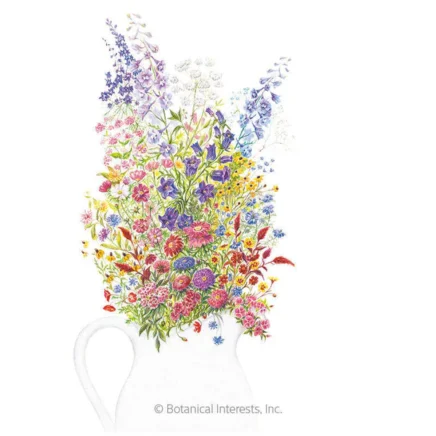
Grandmother’s Cut Flower Garden Flower Mix Seeds
Not Enough Sunlight
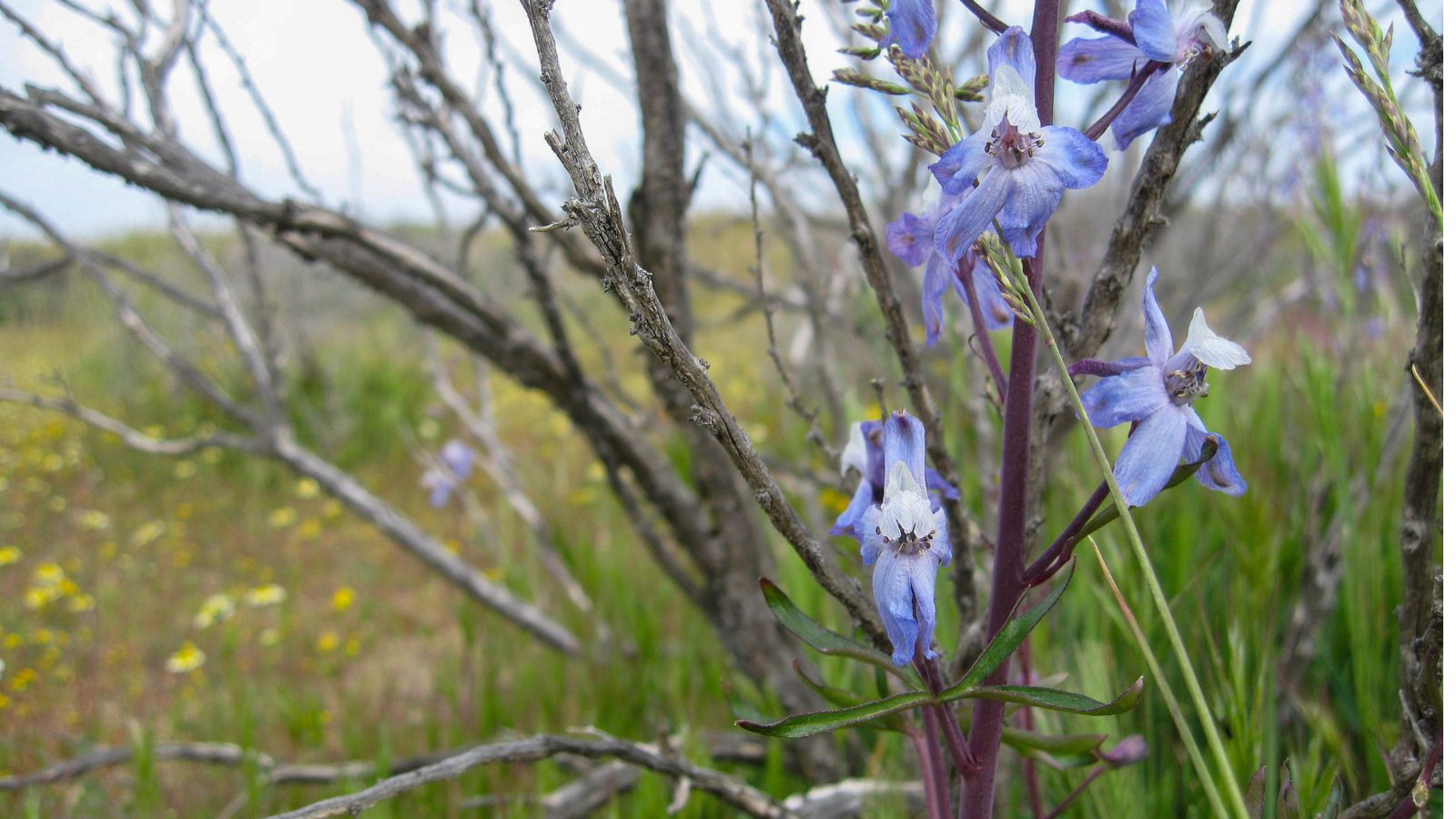 Plant delphiniums in full sun.
Plant delphiniums in full sun.Delphiniums benefit from full sun to produce their towering blooms and also to stave off fungal diseases. They grow and flower best with at least six hours of sunlight daily. They tolerate partial shade (around four hours or more of sun), but too much leads to a lack of flowers.
If your specimen shows spindly spikes, weak stems, or a lack of flowers altogether, check the exposure as the sun moves through the space throughout the day. It may be an easy case of needing to relocate to a sunnier locale.
Alternatively, too much intense sun can burn leaves. In hot climates, larkspur benefits from protection from direct midday sun. They’ll appreciate light shade or dappled conditions in the heat of the afternoon. Lots of morning sun is ideal.
Soggy Conditions
While delphiniums are low maintenance in the right conditions, one thing they won’t tolerate is overly wet soils. Well-draining soils are essential to healthy roots and upper growth. With long taproots, the perennials have the ability to reach moisture well below the soil surface, allowing them to tolerate short dry spells (though they do best with evenly moist soils).
Overly saturated situations arise either from overwatering or poorly draining soils, or both. As the roots sit in saturated soils that lack drainage, they’re likely to succumb to fungal diseases like root and crown rot.
Watering
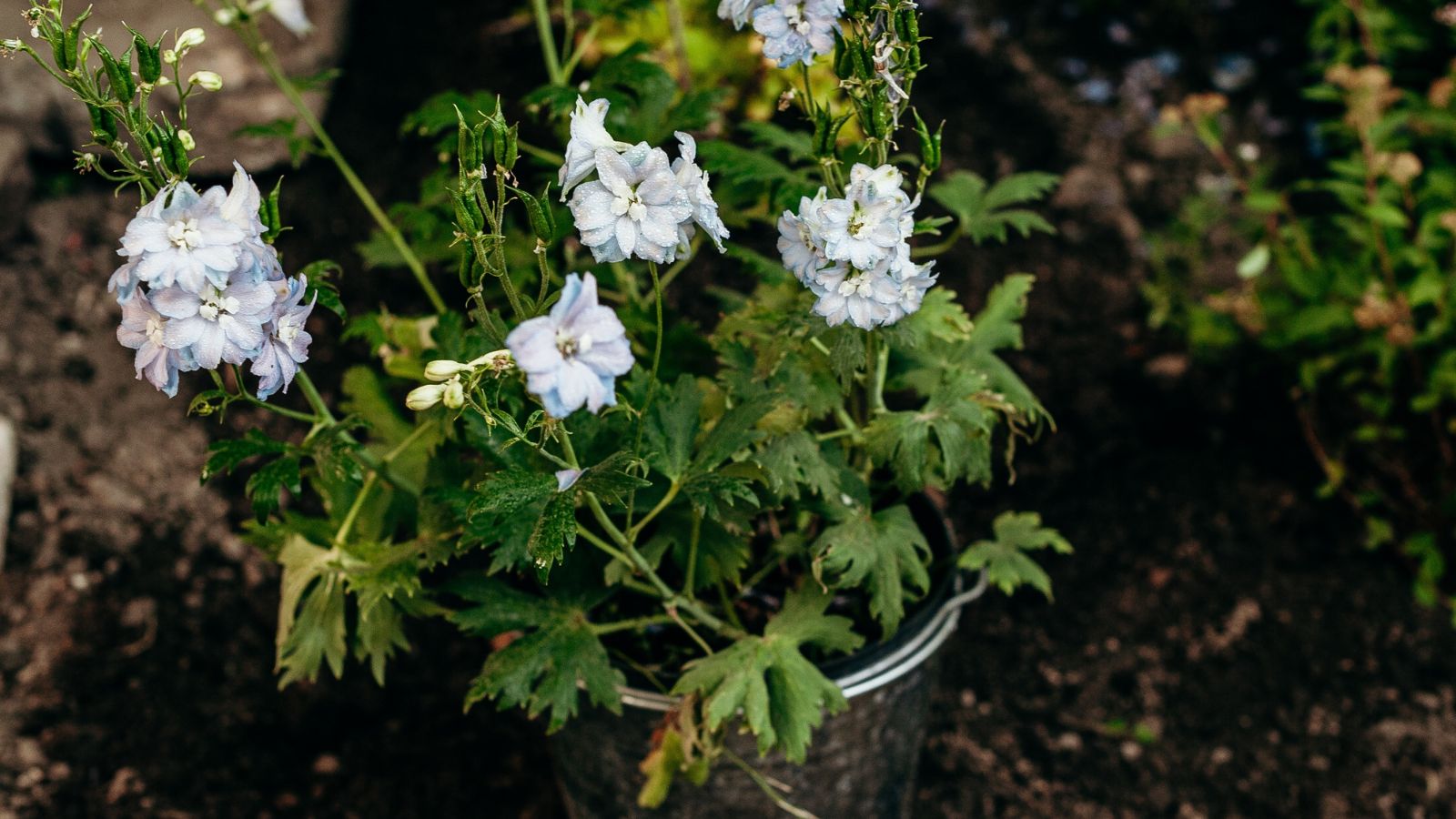 Overly dry or wet soils can cause lack of vigor.
Overly dry or wet soils can cause lack of vigor. If you notice delphinium problems like weak stems, yellowing, wilting leaves, and an overall lack of vigor, check the soil moisture. Touch the surface and a few inches below to determine if the soil is dry and crumbly or wet and sticky. If dry, it’s time to water. If on the wet side, reduce the frequency of irrigation.
Allow soil to dry slightly between watering sessions to an inch or two below the surface. In dry spells or during rainless weeks, supplement with deep watering once or twice as needed to achieve even moisture.
Root and Crown Rot
 Humid conditions and soggy soil may lead to root rot.
Humid conditions and soggy soil may lead to root rot. Root rot and crown rot are delphinium problems that occur in humid environments and overly wet conditions with poor air circulation. With root rot, the pathogen Phytophthora, among others, impacts feeder roots, which become unable to absorb water and nutrients. Signs of root rot include drought-stressed leaves that turn yellow and wilt.
Check for rot by inspecting stems and roots slightly below the soil line. Rotting roots will be yellow or brown rather than a healthy white. With crown rot, brown patches and rotting may appear where the leafy stems emerge just above the soil line. Brown or black lesions may occur.
The best way to prevent rot is to avoid overhead watering and saturated situations. Water at the base, either by hand or with drip irrigation or soaker hoses. These deliver moisture to the roots without splashing foliage or harboring damp situations. Increase air circulation, especially in humid conditions. At planting, take care not to bury the crown or plant too deeply. Compensate for settling by planting just slightly above the soil level.
Remove any severely impacted larkspur. For root rot, try lifting the plant, trimming the decaying root portions, and replanting it in higher ground. There’s a chance it may rebound if caught early, though delphinium roots are sensitive to disturbance, so hedge your bets.
Powdery Mildew
 Keep foliage dry to avoid powdery mildew.
Keep foliage dry to avoid powdery mildew. Powdery mildew is a common delphinium problem. It goes hand in hand with damp conditions from prolonged moisture (rain or irrigation) as well as a lack of air circulation. Be on the lookout for a grayish-white spotty coating that appears on the leaves, stems, and buds.
Mildew rarely kills plants, as it needs living tissue to survive, but it can cause stress and hinder growth and flowering. Leaves may turn yellow, distort, and drop. Horticultural oils like neem can treat the fungal disease early on. Opt for resistant varieties and those that tolerate heat and humidity.
To prevent powdery mildew, practice good irrigation for delphinium, avoiding wetting the leaves when possible to prevent spores from splashing up and spreading. If using overhead irrigation, water early in the day so foliage dries in the sun and breeze.
Plant delphiniums with the proper spacing according to the variety for ample air movement around leaves and stems. Prune away any plants that encroach and may foster damp conditions. If established clumps become crowded, divide them in early spring when new growth emerges. Capture a strong stem and leave plenty of roots intact on each divided portion. Division rejuvenates the colony with proper spacing, access to nutrients and sunlight, and room to continue growing.
Lack of Nutrition
 Delphiniums love organically rich soil.
Delphiniums love organically rich soil. Larkspur are heavy producers and heavy feeders, too. They use a lot of energy and nutrients in flowering and seeding, especially tall varieties. Organically rich soils are the best foundation, where they thrive without supplemental nutrition. Amend soils with compost at planting to aid in nutrition, aeration, and moisture retention.
But, for the biggest, longest-lasting show, a boost in nutrients is helpful. If your delphinium shows yellowing leaves and a lack of flowers (and excess water doesn’t seem to be the issue), it may benefit from fertilizer. Apply a formula specific to blooming plants or a low-grade, balanced one during the growing season. Apply the feed monthly for best results.
Take care not to offer too much fertilizer, as an excess of nitrogen leads to weak, leafy growth instead of the beautiful blooms. Excessive fertilizer also makes delphinium more susceptible to diseases.
Leaf Damage
If you spot holes in the leaves or yellowing, stunting, and dropping, pests and diseases may be the cause. After checking sun exposure, water issues, and nutrition needs, scouting for pests and diseases helps in early detection.
Besides root and crown rots and powdery mildew, delphiniums are subject to other problems, including botrytis and leaf spot.
Botrytis
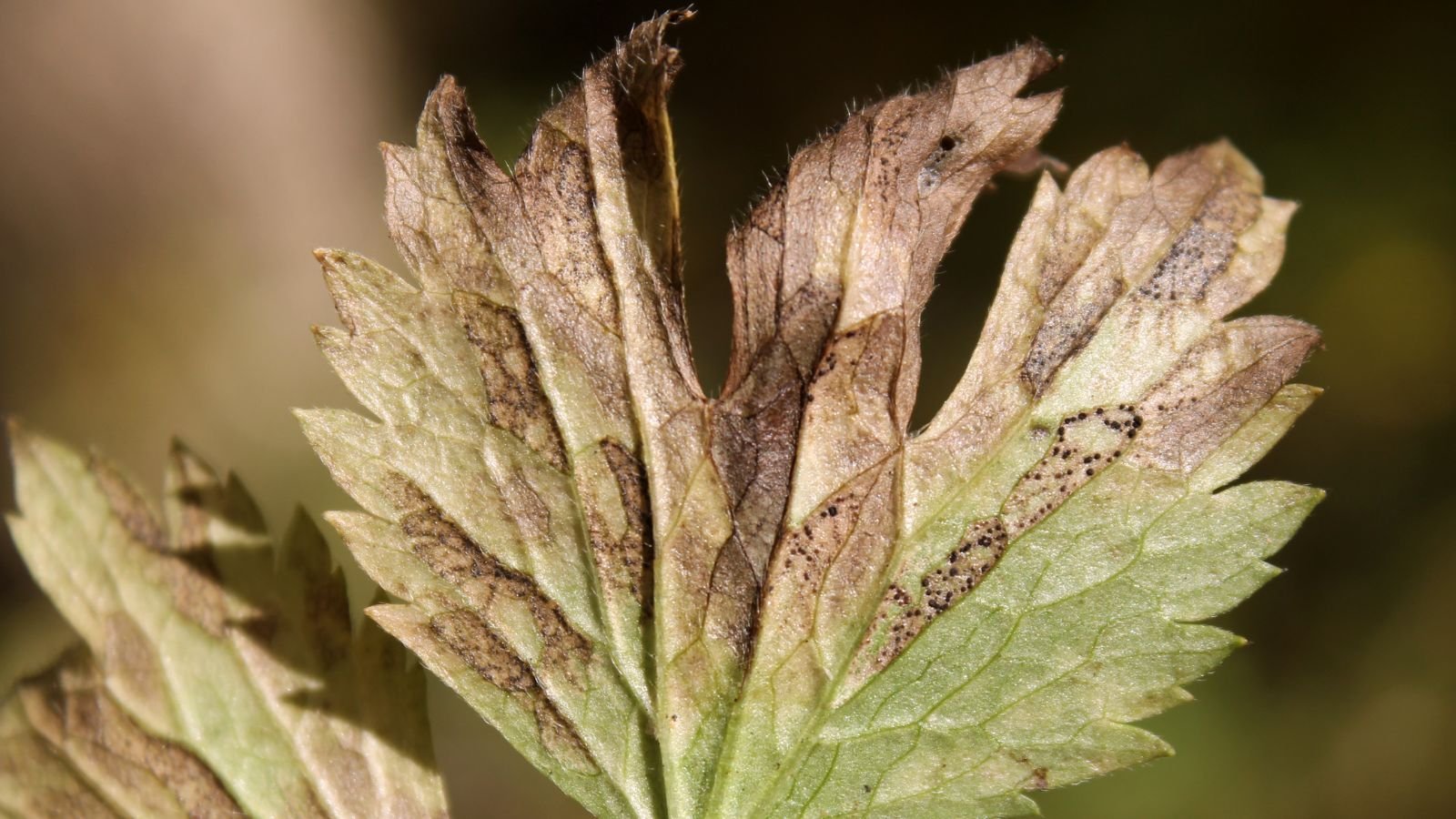 Good airflow is critical for prevention of fungal diseases.
Good airflow is critical for prevention of fungal diseases.Like powdery mildew, botrytis thrives in high humidity and intensifies with limited air circulation. Botrytis cinerea, also called gray mold, is a blight that brings light grayish-brown watery spots on petals and leaves. They discolor, and a “fluffy” mold pops up. Stems may develop tan-brown cankers that cause them to collapse.
Try to limit damp conditions with proper spacing and by avoiding wetting the leaves unnecessarily. Be mindful of overwatering or overfertilizing, which cause weakness and increase susceptibility. Remove fallen debris at season’s end to minimize harboring the spores.
Neem oil is an effective treatment early on, as is potassium bicarbonate. A powdered formula mixed with water is useful as a regular spray treatment. Mycorrhizae and beneficial bacteria added to the soil offer countermeasures. Look for Trichoderma and Cladosporium to help ward off botrytis.
Leaf Spot
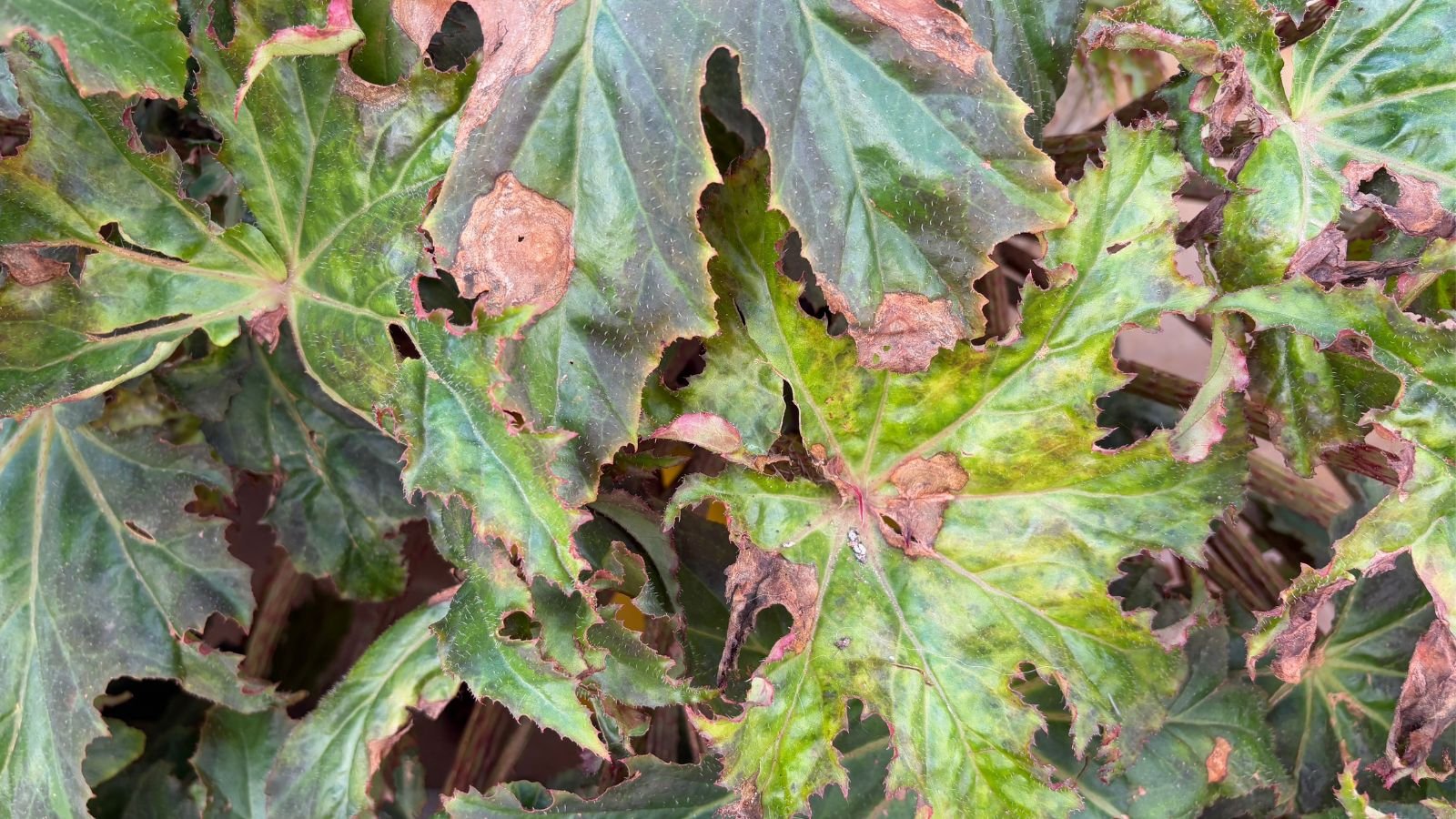 Cut off visibly diseased leaves.
Cut off visibly diseased leaves.Leaf spot is a common fungal infection that grows on leaf surfaces. Brown spots with tan centers become more significant and spread across leaves and stems over time. The fungi cause affected leaves and stems to blacken.
The likelihood of leaf spot increases in wet conditions, with the spots appearing when leaves stay wet from lengthy rains or overhead watering. Proper plant spacing is the best preventative, along with ground-level watering. Apply a mulch layer to reduce soil splash during watering. Mulch also offers other benefits like temperature regulation, moisture retention, and weed suppression.
When you see leaf spot, cut off diseased leaves and remove any that drop to avoid overwintering. Sanitize pruners while moving between plants. An alcohol wipe or a dip in a 70% isopropyl alcohol solution is handy while working.
Slugs
 Slugs are a common delphinium problem.
Slugs are a common delphinium problem. Slugs and snails slide across leaves to feed on soft shoots and tender new growth early in the season. They’re most active in cool, damp conditions in the evening or early morning. You’ll notice irregular holes in leaves and petals and their sluggy trail.
Hand-pick slugs off the perennials during their active times. In the middle of the day, they hide under leaves, mulch, and soil. Lure them with lettuce leaves or citrus rinds and collect them in the morning. If numbers increase, bait them with beer or soda traps by filling a shallow dish and placing it at soil level. Remove mulch from around the crown to stave off protective hiding spots. Diatomaceous earth scattered around the base of the stems contains sharp particles that harm soft-bodied creatures as they crawl. Reapply after heavy rains to maintain the boundary.
Target irrigation at the root level to reduce damp conditions, which are an inviting habitat for the creatures.
Aphids

Aphids are soft-bodied sap-feeding pests that congregate in large numbers underneath leaves. The pear-shaped insects feed on tissues, especially on new shoots. With an aphid infestation, you’ll find leaves that curl and cup before they turn yellow, brown, and drop. They leave behind a sticky honeydew, which often becomes an unattractive black sooty mold in humid conditions.
Spray the leaves and stems with a stream of water to displace the insects. Aphids reproduce quickly, and if the population is large, an insecticidal soap or oil can be effective.
Provide even moisture, sunlight, and the best growing conditions to build defenses against pests. Grow a diversity of flowering plants to attract beneficial predators that feed on aphids and other common offenders. Ladybugs, hoverflies, and parasitic wasps are the best natural defense in aphid management.
Flopping Over
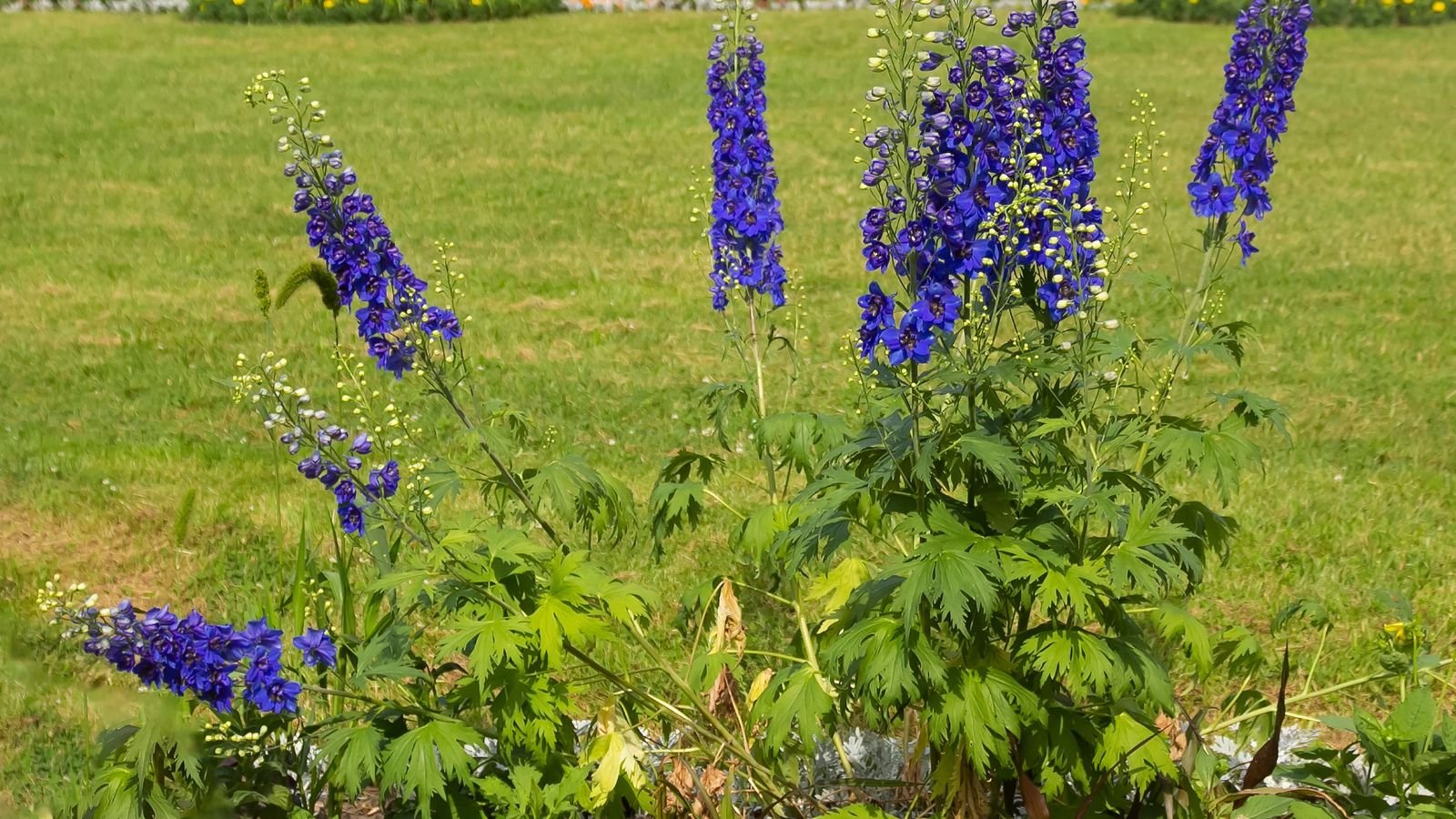 Stake tall varieties.
Stake tall varieties. With their tall spires, delphiniums have the problem of falling over under their own petal and stem weight. Tall varieties need staking, starting at about two feet high. Install the support during planting, using a stake or pole at the mature height of the variety. Allow for six inches or more beneath the ground level for stability. Tie off stems as they grow, every several inches or so.
Situate tall larkspur varieties out of windy sites. Offer a windbreak with larger shrubs, perennials, or structures, still allowing plenty of airflow.
Delphinium grows beautifully in containers, just install supports and secure stems as they grow. Compact, bushy types are more self-supporting and reach two to three feet. They’re ideal for pots and the front of the border.
Not Deadheading
 Deadhead spent flower stalks after blooming.
Deadhead spent flower stalks after blooming. Deadhead spent flower stalks post-bloom, cutting them back to the basal leaves or to side shoots, if present. Let any side shoots flower before giving them a cut, too.
Deadheading promotes a possible rebloom in late summer and early fall. It directs energy to the roots and stems rather than into seed production. Deadheading also prevents reseeding; species of delphinium are vigorous spreaders that can take over a space. And, hybrids won’t come true to type from seed, differing from the parent plant. But to encourage reseeding, leave the stalks in place, or prune for a rebloom and let those go to late-season seed.


 2 weeks ago
25
2 weeks ago
25





















 English (US) ·
English (US) ·  French (CA) ·
French (CA) ·